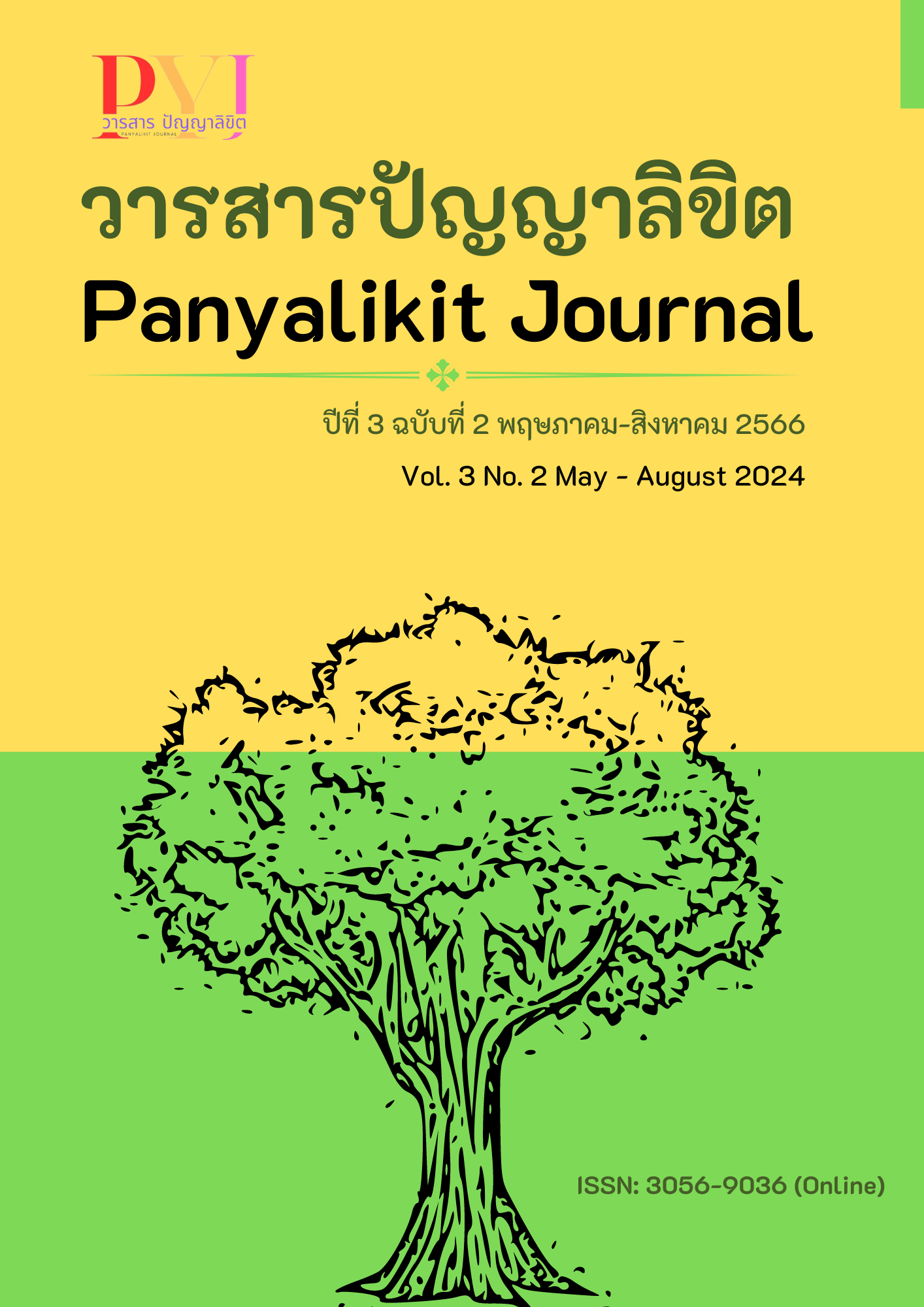Faith and virtue of Phra Rajawacharathammasophon (Luang Pu Maha Sila Sirichantho)
Main Article Content
Abstract
This academic article aims to study the virtues and spiritual qualities of Phra Ratchawat Chara Tham Sopa or Luang Pu Maha Sila Sirichanto. The study's findings reveal that Luang Pu Maha Sila Sirichanto embodied the Four Sublime States (Brahmaviharas), which are: Loving-kindness (Metta) refers to a mental state filled with warmth, friendliness, and goodwill, aimed at benefiting others with happiness. It is free from hatred and ill-will, characterized by a genuine wish for all beings to be happy, without any harmful or malicious intentions. Compassion (Karuna) refers to a mental state that resonates with the suffering of others, as if one has taken on their suffering and is determined to relieve it. It manifests as an inability to remain indifferent, compelling one to actively help alleviate the suffering. It is devoid of any desire to harm or exploit others. When witnessing someone in distress with no one to turn to, compassion drives the urge to offer assistance.Sympathetic joy (Mudita) refers to a mental state of genuine happiness and delight in the success and prosperity of others. It is free from envy, as one feels joy when seeing others blessed with wealth or good fortune. Mudita removes any feelings of resentment and replaces them with sincere joy for others' achievements without any trace of jealousy. Equanimity (Upekkha) refers to a mental state of neutrality and balance, viewing all beings equally in both fortunate and unfortunate circumstances. It is neither elated nor dejected, recognizing that each person has their own karma, which determines whether they experience happiness, escape suffering, or maintain their wealth. This understanding allows one to remain detached and calm, letting things unfold according to karma, without clinging or becoming entangled in them.
Luang Pu Maha Sila Sirichanto selflessly devoted himself to serving the greater good, sacrificing his own happiness for the benefit of the community. He practiced the virtue of generosity (Dana Paramita) by donating his wealth to others, such as contributing funds to hospitals for purchasing medical equipment, supporting the construction of special rooms, and building monks' dwellings that were in disrepair. Additionally, he made numerous charitable donations during various occasions. Luang Pu lived a humble and simple life, adhering to virtuous conduct. He became a source of refuge for the poor, aiding society and contributing to public welfare. His actions earned him great respect and faith from Buddhists across the region.
Article Details

This work is licensed under a Creative Commons Attribution-NonCommercial 4.0 International License.
References
นฤมล มารคแมน. (2560). อิทธิปาฏิหาริย์ของพระพุทธเจ้า. วารสารรามคำแหง ฉบับมนุษยศาสตร์, 36(2), 157-172.
นิตยา นิยมวงศ์. (2555). การศึกษาคุณธรรมตามหลักพรหมวิหาร 4 ของผู้บริหารสถานศึกษาตามทัศนะของครูผู้สอน สังกัดสำนักงานเขตพื้นที่การศึกษาจันทบุรีเขต 2 (วิทยานิพนธ์ครุศาสตรมหาบัณฑิต). มหาวิทยาลัยราชภัฏรําไพพรรณี.
ผาสุก มุทธเมธา. (2535). คติชาวบ้าน กับการพัฒนาคุณภาพชีวิต (ฉบับปรับปรุง). กรุงเทพฯ: โอ.เอส.พริ้นติ้ง เฮ้าส์.
พระชลญาณมุนี (สมโภช ธมฺมโภชฺโช) และ สรวิชญ์ วงษ์สะอาด. (2563). พระพุทธศาสนากับความเชื่อ. วารสาร มจร บาฬีศึกษาพุทธโฆสปริทรรศน์, 6(2), 99-115.
พระโดม อมโร. (2561). ศึกษาการบำเพ็ญบารมีและการบรรลุธรรมของพระธัมมาเถรี (วิทยานิพนธ์พุทธศาสตรมหาบัณฑิต). มหาวิทยาลัยมหาจุฬาลงกรณราชวิทยาลัย.
พระธรรมกิตติวงศ์ (ทองดี สุรเตโช, 2546). คำวัด โอวาท โอวาทกถา. สืบค้นเมื่อ 16 สิงหาคม 2567, จาก https://kalyanamitra.org/th/article_detail.php?i=3907
พระพรหมคุณาภรณ์ (ป.อ. ปยุตฺโต). (2551). พจนานุกรมพุทธศาสน์ ฉบับประมวลศัพท์. (พิมพ์ครั้งที่ 12).กรุงเทพฯ: มหาวิทยาลัยมหาจุฬาลงกรณราชวิทยาลัย.
พระพรหมคุณาภรณ์ (ป.อ.ปยุตฺโต). (2552). พจนานุกรมพุทธศาสตร์ ฉบับประมวลธรรม. พิมพ์ครั้งที่ 17. กรุงเทพฯ: จันทร์เพ็ญ.
พระสมุห์สายัณ จนฺทวณฺโณ. (2554). การศึกษาวิเคราะห์จาคะในพระพุทธศาสนาเถรวาท (วิทยานิพนธ์พุทธศาสตรมหาบัณฑิต). มหาวิทยาลัยมหาจุฬาลงกรณราชวิทยาลัย.
พระอุดรคณาธิการ และ จำลอง สารพัดนึก. (2530). พจนานุกรมบาลี-ไทย ฉบับศึกษา. พิมพ์ครั้งที่ 2.กรุงเทพฯ: มหาจุฬาลงกรณราชวิทยาลัย.
พีรญา สหรัตพณ. (2564). การศึกษาความสัมพันธ์ระหว่างศรัทธาและความสุขของวัยรุ่นตามแนวพุทธจิตวิทยา. วารสารพุทธจิตวิทยา, 6(1), 41-51.
เพจทรูปลูกปัญญา. (2564). โอวาท 3. สืบค้นเมื่อ 16 สิงหาคม 2567, จาก https://www.trueplookpanya.com/learning/detail/3339
เพจโอวาทธรรมหลวงปู่ศิลา สิริจันโท. (2567). โอวาทธรรม หลวงปู่ศิลา สิริจันโท. สืบค้นเมื่อ 16 สิงหาคม 2567, จาก https://www.facebook.com/
มหาวิทยาลัยมหาสารคาม. (2564). พระครูปลัดวชิรโสภณญาณ (ศิลา สิริจันโท) บริจาคเงินกว่า 1,000,000 บาท สมทบสร้างหออภิบาลสงฆ์ สนับสนุนทางด้านการเเพทย์ รพ.สุทธาเวช มมส และสงเคราะห์สาธารณประโยชน์. สืบค้นเมื่อ 16 สิงหาคม 2567, จาก https://news.msu.ac.th/mnews/msuhotnews/detailnews.php?hm=&hotnewsid=9529&uf=&qu
สถานีวิทยุกระจายเสียงแห่งประเทศไทย. (2564). หลวงปู่พระมหาศิลา สิริจันโท ได้บริจาคเงิน 1,000,000 บาท เพื่อจัดซื้ออุปกรณ์ทางการแพทย์ให้กับโรงพยาบาลร้อยเอ็ด. สืบค้นเมื่อ 16 สิงหาคม 2567, จาก https://radioroiet.prd.go.th/th/content/category/detail/id/9/iid/41324
สารานุกรมเสรี. (2567). ประวัติพระราชวัชรธรรมโสภณ (ศิลา สิริจนฺโท). สืบค้นเมื่อ 16 สิงหาคม 2567, จาก https://th.wikipedia.org/wiki/
สำนักข่าว sanook news. (2565). เปิดประวัติ "หลวงปู่ศิลา" เกจิดังภาคอีสาน ลูกศิษย์เล่าปาฏิหาริย์ มีญาณหยั่งรู้อุบัติเหตุ. สืบค้นเมื่อ 16 สิงหาคม 2567, จาก https://www.sanook.com/ news/8599266/
สำนักข่าว Sanook. (2567). คนแห่ขอเลข! ผู้เฒ่าเล่าปาฏิหาริย์ "หลวงปู่มหาศิลา" หยั่งรู้ล่วงหน้า บอกหวย-ชื่อโจรตรงเป๊ะ. สืบค้นเมื่อ 20 สิงหาคม 2567, จาก https://www.sanook.com/ news/9497386/
สำนักข่าวคมชัดลึก. (2565). รู้จักเกจิดังภาคอีสาน "หลวงปู่ศิลา" รอดปาฏิหาริย์ เหตุรถเสียหลักพุ่งชน. สืบค้นเมื่อ 16 สิงหาคม 2567, จาก https://www.komchadluek.net/believe/spiritual/524204
สำนักข่าวอมรินทร์ทีวี. (2567). เปิดประวัติหลวงปู่ศิลา ตำนานภาพปิดทองหลังพระของจริง. สืบค้นเมื่อ 16 สิงหาคม 2567, จาก https://www.amarintv.com/article/detail/64721


